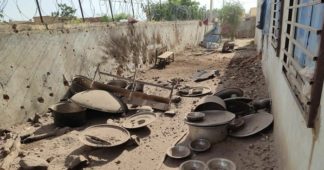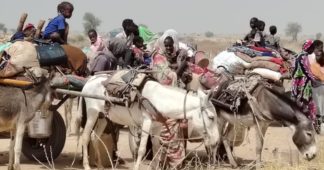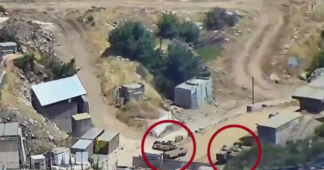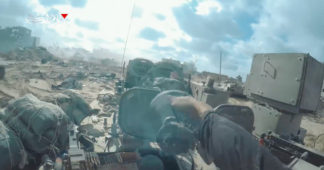With the last resistance fighter defending the city falling in battle, the besieged capital of North Darfur is under the control of paramilitary RSF, which has killed “most of the civilians who had remained inside”
by Pavan Kulkarni
October 29, 2025
Sudan’s paramilitary Rapid Support Forces (RSF) have killed “most of the civilians who had remained inside” North Darfur’s capital El Fasher, the Coordination of Resistance Committees (RC) in the city said in a statement on Tuesday, October 28.
According to the UN, about 260,000 civilians, including 130,000 children, were trapped in this city, besieged by the RSF for over 500 days since last May. Cut off from food supply, its residents had survived on animal fodder.
Even animal fodder has been inaccessible for most since last week, after the RSF completed the construction of a 57-km wall around the city to totalize the siege and stop the flow of the meager supplies that were being smuggled in through the siege.
With no international action to break the siege or airdrop of supplies, death by starvation was a sealed fate – but death came sooner, by metal and fire.
Raining shells on the starving, thousands of RSF troops in armored vehicles and tanks launched an attack on the city from all axes on Saturday, October 25. Sick, wounded, and hungry, the local fighters of the Popular Resistance held ground alongside the soldiers of the Sudanese Armed Forces (SAF), defending its last remaining foothold in Darfur.
The rest of this western region of Sudan, with five of its 18 states, had already been taken over by the RSF, with El Fasher being SAF’s last holdout. RSF had already attacked the city over 260 times in this war, but was repelled by determined resistance each time.
On Sunday, however, the RSF managed a breakthrough from the east as the fighters defending the city on that front fell under heavy fire, with no air support from the SAF. Condemning Abdel Fattah al-Burhan, the SAF chief and head of the government based in Port Sudan, for abandoning his soldiers, the RC shared a video of the aftermath.
Scores of SAF soldiers and Popular Resistance fighters lay dead in the trenches amid the burning wreckage of their pickup trucks that blackened the air with thick smoke. Distant gunfire continued in the background.
Taking over the 6th Infantry Division headquarters, SAF’s last military base in Darfur, the RSF claimed control of El Fasher on October 26. Contesting premature media reports of El Fasher’s fall at the time, the Popular Resistance insisted that RSF’s overrunning the military base did not mean the fall of El Fasher.
Vowing to resist till the end, its fighters retreated to better fortified positions and continued to engage the RSF in several parts of the city. “We affirm that El Fasher… will remain defiant,” insisted its statement.
“Battles continue, and the fighters remain steadfast,” the RC reported. Despite Burhan’s “betrayal”, it added, “the sons of this city will hold out to their last breath… Then history will remember who resisted… and who left their soldiers and commanders to fight alone.”
They fought on for three days until the evening of October 28, when the RC reported that “the last resisting soldier fired his last bullet” and “then fell as a martyr.” The guns have gone silent. “The city has fallen, but its dignity has not.”
Massacres, summary executions, burning of homes
The RSF then rounded up the wounded resistance fighters and civilians in the Saudi hospital, one of the last partially functioning in the city, in a building shelled multiple times. Its troops then “collectively executed” them all, the RC reported later in the evening. They also reportedly abducted medics, demanding USD 250,000 from their families for their release.
RSF’s atrocities in the El Fasher “constitute crimes against humanity and war crimes, and some of them even amount to genocide,” the Darfur Bar Association said in a statement.
The RSF is committing “heinous massacres against unarmed civilians” and “burning of homes”, added the Sudanese Doctors’ Syndicate in a statement calling for the setting up of “field emergency centers” in nearby villages receiving those who have managed to escape El Fasher.
According to the International Organization for Migration (IOM), at least 26,000 people fled the city in the two days since October 26. It is unclear how many survived. The RSF troops have posted many videos of themselves chasing down the fleeing civilians in armored vehicles with machine guns, whiplashing them into a line, only to summarily execute them with gunshots.
The best chance of survival for those who managed to escape is to walk over 60 kilometers to Tawila, past the bodies of many who had fled earlier, but succumbed en route to hunger, thirst, wounds, or fresh attacks by bandits on the lawless stretch.
Those who survive the journey and reach Tawila lack the “basic life-saving services, including water and food”, said Adam Rojal, spokesperson of the General Coordination of Darfur Displaced People and Refugees. The overcrowded camps for the displaced, already hosting 650,000 people, were a hotspot of cholera recently.
Nevertheless, those reaching these camps are the lucky ones. “New arrivals have recounted stories of widespread ethnically and politically motivated killings” in El Fasher, “including reports of people with disabilities being executed because they were unable to flee,” the UN reported. Others were “shot as they tried to escape.”
A long chain of international complicity
In the meantime, the UN Secretary-General, António Guterres, “as usual, merely repeated expressions of concern and condemnation… in words only… without taking effective measures to protect civilians on the ground,” said the Darfur Bar Association. “Had those measures been taken on time, the killing of innocents and the bloodshed that occurred – and continues to occur – in El Fasher could have been avoided.”
The RC insists that “El Fasher was not defeated – it was betrayed”. SAF chief Burhan and the UN were not the only betrayers. “There are a lot more people responsible for what’s going on in El Fasher,” said Ahmed Kaballo, a Sudanese national and founder of the persecuted pan-African media platform, the African Stream.
Kenya’s President Willian Ruto allowed the RSF to form a parallel government in Nairobi. “The European Union funded… the RSF, knowing that they were a blood thirsty mercenary group. They gave them support, not despite this, but because of this,” thinking “who better to police the Mediterranean” and “stop the refugees from coming to Europe”.
Britain “pressured African governments not to condemn the UAE for their role in supporting the RSF,” he added. After all, the RSF is using British-made military equipment, likely supplied to it by the UAE.
Chad, Ethiopia, and General Haftar in Libya are helping the UAE smuggle weapons into RSF-controlled territories, and smuggle out the gold mined from mineral-rich Darfur to Dubai, Kaballo listed on. The UAE “is the main beneficiary of the chaos and the destruction we are seeing in El Fasher.”
UAE hosts much of RSF’s financial network behind the war machine, consisting of numerous owned or associated companies.
The US has formally sanctioned RSF “Leader, Weapons Supplier, and Related Companies.” However, the gentle form of sanctions has not shut down its corporate network in the Emirates.
The Trump administration had hosted an RSF delegation in Washington DC on October 24 for indirect negotiations with the SAF delegation led by Sudan’s foreign minister. Also present were the representatives of Egypt, Saudi Arabia, and the UAE.
With the UAE refusing to discuss El Fasher, negotiations collapsed hours before RSF started the attack, the Middle East Eye (MEE) reported. While the SAF delegate demanded that the US rein in the UAE’s support for the RSF, Trump’s envoy for Arab and African affairs, Massad Boulos, demanded that the SAF stop purchasing arms from Iran.
He also reportedly insisted that SAF should reiterate its normalization of diplomatic ties with Israel. SAF had already signed the Abraham Accords in 2021, but as part of a military junta in which it had shared power with the RSF, alongside token ministries for a technocratic civilian component, which was jointly removed by the SAF and the RSF in a coup only months later.
How SAF helped create the RSF?
The history of collaboration between the SAF and the RSF is over a decade old. The RSF was formed in 2013 by coalescing the Janjaweed militias spawned by the SAF to commit mass atrocities during the Darfur civil war in the 2000s.
The militias were recruited from the tribes of nomadic, Arabic-speaking cattle herders, who, amid depleting fertile land and water due to desertification, were already in conflict with the local settled farmers, who spoke African languages. When these local, darker-skinned populations rebelled against marginalization, the regime, then ruled by the dictator, Omar al-Bashir, ethnicized the war as a conflict between Arabs and Africans.
Burhan was SAF’s commander in Darfur at the time. RSF was later formed by placing the Janjaweed militias under the command of Mohamed Hamdan Daglo, whom Bashir baptized as “Hemeti” – meaning “my protector” – setting up his force as a guardian against any potential military coups.
However, under the pressure of mass pro-democracy protests that erupted in December 2018, Burhan and Hemeti teamed up to remove Bashir in a coup in April 2019.
Unwilling to settle for a military junta formed by the SAF and the RSF as the replacement for Bashir’s government, mass protests, led by the network of RCs organized in localities across Sudan’s cities, continued until the war started in April 2023.
Since then, the RCs have been at the forefront of organizing relief and rescue for civilians in Sudan, over 14 million of whom have been forced to flee, in what is the world’s largest displacement crisis.
“We will stay here resisting until our last breath,” several activists of El Fasher’s RC declared when the attack started. Three days later, on the morning of October 28, the RC reported “most of the civilians who remained inside the city have been killed.”
We remind our readers that publication of articles on our site does not mean that we agree with what is written. Our policy is to publish anything which we consider of interest, so as to assist our readers in forming their opinions. Sometimes we even publish articles with which we totally disagree, since we believe it is important for our readers to be informed on as wide a spectrum of views as possible.











